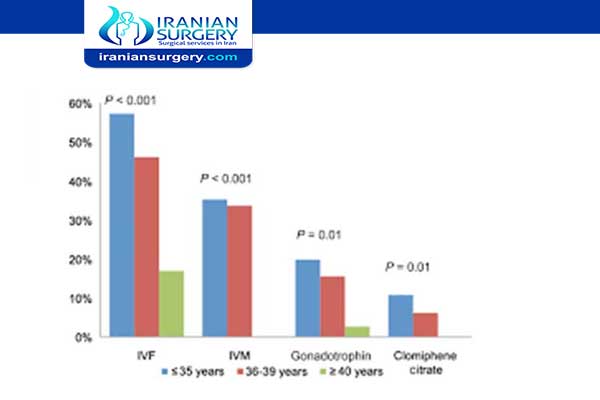Does IUI work over 40?
Is 42 too old for IVF?
Can I get pregnant at 42 with IUI?
How successful is IUI at 41?
IUI
IUI is a simple office procedure that places sperm, collected from the partner and processed in the laboratory, into the uterine cavity. The "washing" of sperm in the lab removes seminal fluid (which can cause severe cramping) and concentrates the sperm. Placing the sperm higher into the uterine cavity bypasses the cervix and makes the passage to the fallopian tubes much shorter. The goal is to increase the chance that more sperm will encounter the egg.
IUI may be performed during a woman's natural ovulation which can be timed with over the counter ovulation predictor kits (OPK) or in conjunction with fertility medication received by the woman to assist in ovulation function.

Read more about : Ivf in Iran
Read more about: 2nd iui success rate
Read more about: IUI procedure step by step
Read more about : Ivf process start to finish step by step
IUI success over 40
IUI with fertility medication (Clomid): average success rates range from 8% to 15% per cycle for patients under 35 to 2% to 5% for patients over 40.
IVF using a woman's own eggs: average success rates range from 40% to 45% for patients under 35 to 15% or less for women over 42.
Using fresh (that is, not frozen) eggs or embryos from women trying to conceive, at age 40 fewer than 30 percent undergoing I.V.F. became pregnant and fewer than 20 percent gave birth to live babies as a result. The success rate was somewhat better when IVF.
Read more about: iui vs ivf
How to increase IUI success rates?
IUI is generally more successful for mild to moderate male infertility issues. For severe male infertility, IVF treatment is probably a better choice and is likely to be recommended by your clinician or treatment provider.
Research has shown that women who lay down for 15 minutes after IUI were 10% more likely to get pregnant during that cycle than women who got straight up following the procedure. The group that rested had IUI success rates of 27% and the group that got up quickly had IUI success rates of 17%.
Healthy sperm will boost your chances of IVF success, so washing and preparing the sperm sample before insemination is key.
Weaker sperm are separated from the stronger, healthier sperm, and the ‘good’ sperm are concentrated into a high volume in the insemination sample. Any toxins that could cause an allergic reaction in the uterus are removed from the semen.
Read more about: IUI success rate by age
Read more about : kidney cancer survival rates by age
Who Can Benefit from IUI?
IUI can help couples when:
- A woman has ovulation problems and has not been able to conceive using ovulation-inducing fertility medication
- Fertility medication is used to increase the number of eggs a woman normally ovulates
- There are minor abnormalities in the sperm analysis (such as concentration, motility, and morphology or shapes of the sperm)
- Male partner has difficulty ejaculating
- The male partner has frozen sperm obtained prior to surgery or treatment for diseases like testicular cancer
- Donor’s sperm is being used to get pregnant
IUI is often considered as the first line of treatment for unexplained infertility, mild endometriosis, or mild male factor infertility.
Read more about: How to improve iui success rates
Is IUI painful?
The IUI procedure should only take a few minutes and it shouldn't hurt. Some mild discomfort may occur when the speculum is inserted, or you may experience cramping when the catheter passes through the cervix. The discomfort is temporary and should be gone by the end of the procedure.
Read more about: The keys to a have successful IUI
IVF success rate
The success rate of IVF depends on the age of the woman undergoing treatment, as well as the cause of the infertility (if it's known).
Younger women are more likely to have a successful pregnancy. IVF isn't usually recommended for women over the age of 42 because the chances of a successful pregnancy are thought to be too low.
Between 2014 and 2016 the percentage of IVF treatments that resulted in a live birth was:
- 29% for women under 35
- 23% for women aged 35 to 37
- 15% for women aged 38 to 39
- 9% for women aged 40 to 42
- 3% for women aged 43 to 44
- 2% for women aged over 44
These figures are for women using their own eggs and their partner’s sperm, using the per embryo transferred measure.
The Human Fertilisation and Embryo Authority (HFEA) has more information on in vitro fertilisation (IVF), including the latest success rates.
Maintaining a healthy weight and avoiding alcohol, smoking and caffeine during treatment may improve your chances of having a baby with IVF.





2 Comments
hey there
howdy?
I’m Jake Alberta
and I have a question regarding infertility treatments
what’s the IUI vs IVF success Rate?
IVF has a much faster time to pregnancy due to it’s higher success rate per cycle. For those under 35, success rates are generally around 50% per treatment. IUIs generally have a success rate of around 5-20% per cycle. If an IUI is to be successful it most often happens in the first three or four treatment cycles